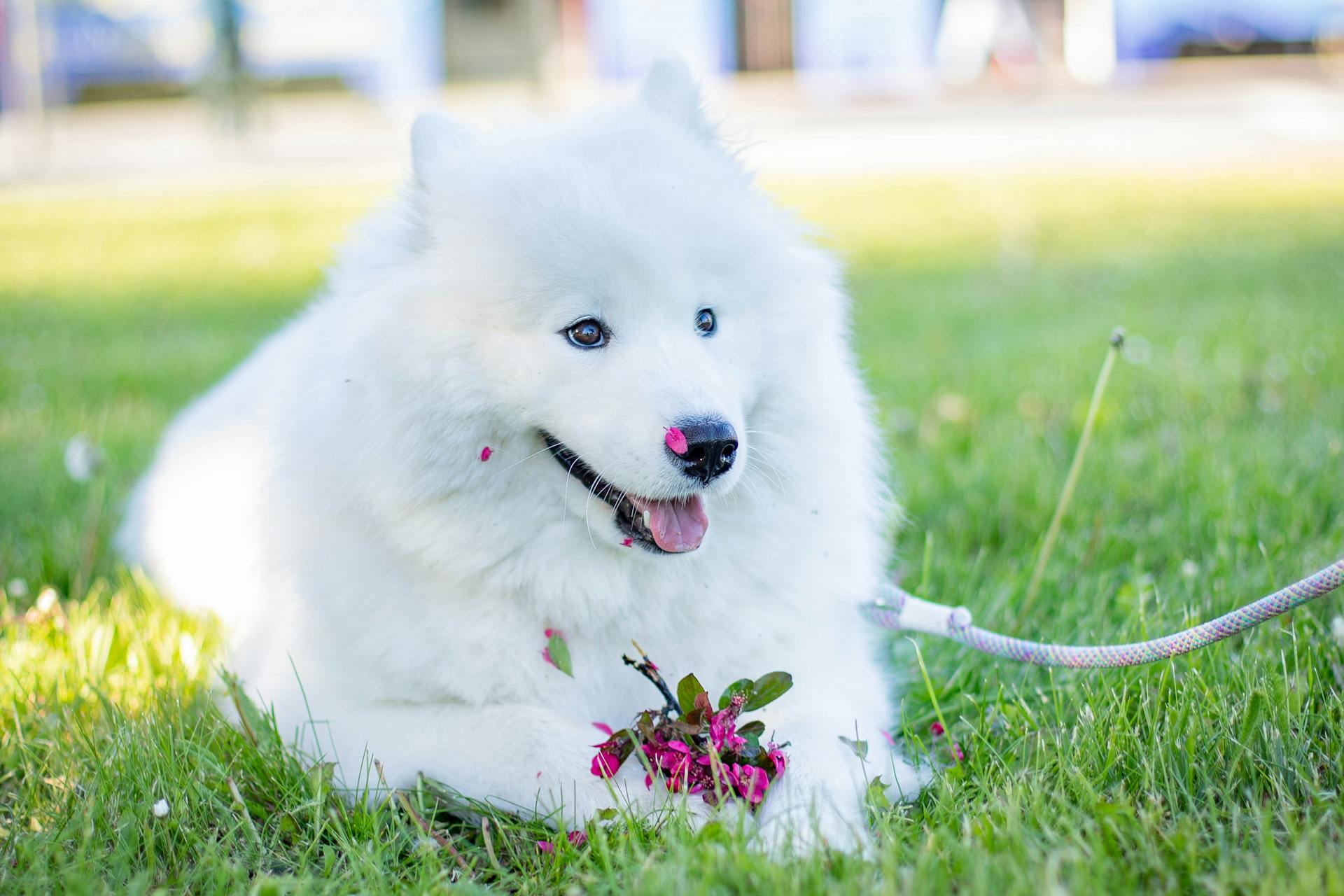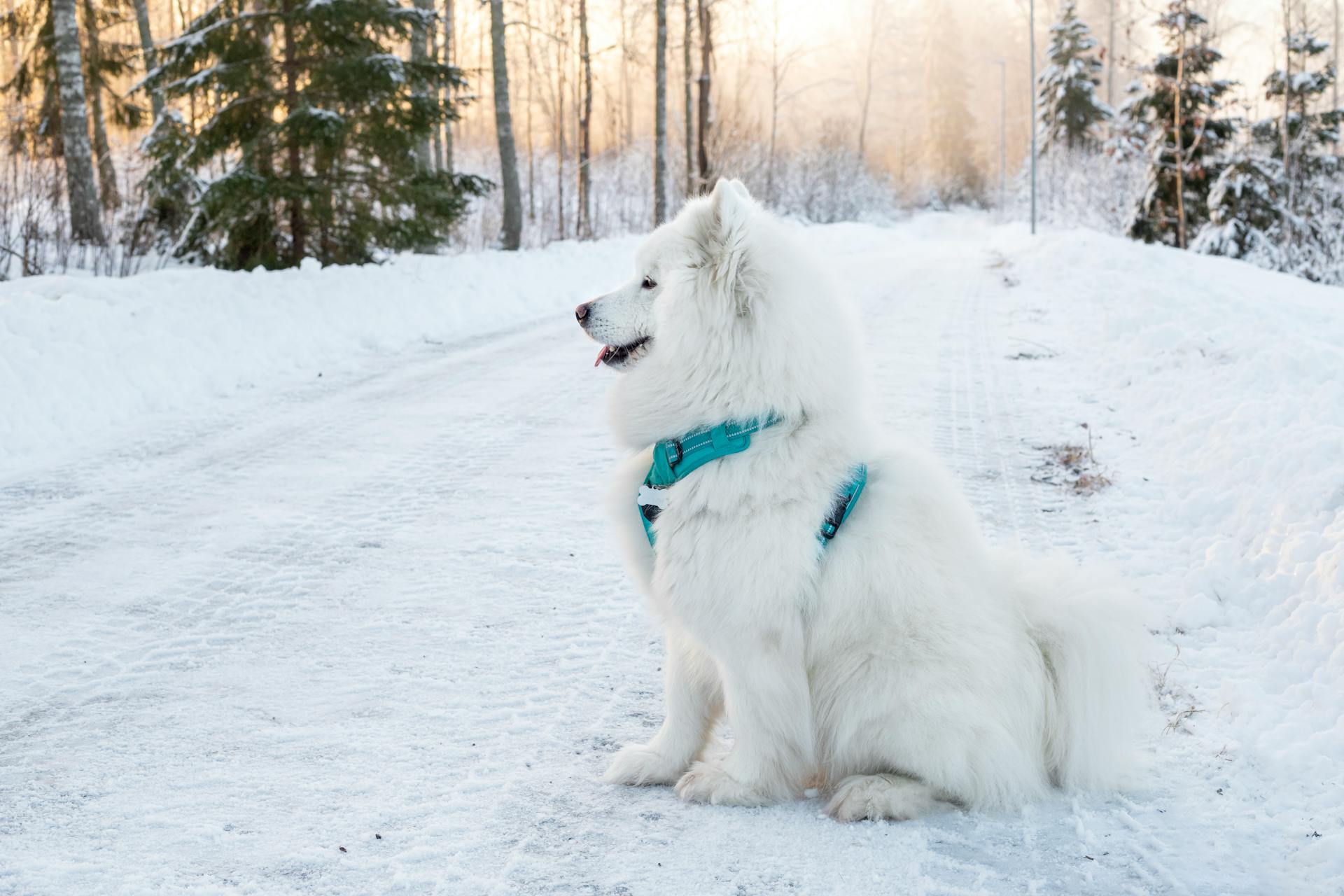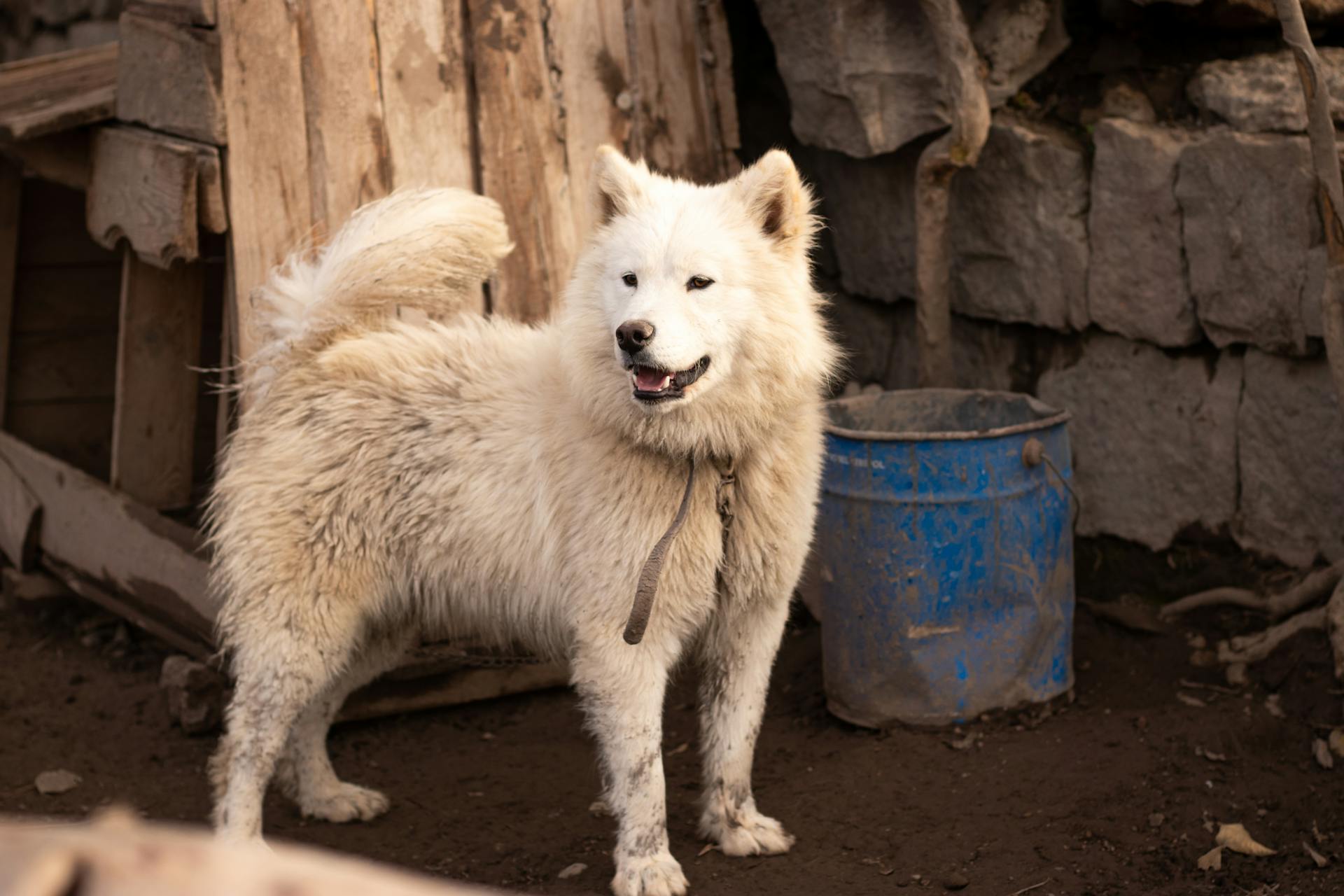
The Samoyed dog breed is a beloved companion for many, known for their fluffy white coats and friendly demeanor. They originated in Siberia as a working dog, helping with herding, hunting, and guarding.
Samoyeds are a medium to large breed, with males weighing between 45-65 pounds and standing 19-23.5 inches tall at the shoulder. They have a sturdy build and a wedge-shaped head with a black nose.
One of the most distinctive features of the Samoyed is their thick, double coat, which sheds heavily and requires regular grooming to prevent matting. This coat also helps to insulate them in cold climates, making them well-suited for their original purpose in Siberia.
Samoyeds are highly intelligent and trainable, but they can be independent and stubborn at times, requiring patient and consistent training.
History and Origins
The Samoyed dog has a rich and fascinating history that spans thousands of years. Its origins can be traced back to the Nenets Herding Laika, a reindeer herding spitz used by the Nenets people in northern Siberia.
The Samoyed breed was originally used to hunt, herd reindeer, and haul sleds for the Siberian Samoyede people. They were treated kindly and allowed to join in with family activities, creating a sense of trust and loyalty that remains today.
The Samoyed's journey out of Siberia began in the late 19th and early 20th centuries, where they were used to pull sleds on polar expeditions. One notable expedition was Sir Ernest Shackleton's journey to the Antarctic, where the dogs endured terrible hardships alongside the explorers.
A Samoyed named Antarctic Buck is said to have been the first brought to England, and Queen Alexandra was an enthusiast of the breed. Many present-day English and American Sammies are descended from her kennels.
The first standard for the breed was adopted in England in 1909, and the original Samoyed Club of America was organized in 1923, the same year the American breed standard was adopted.
The Samoyed's lineage is closely tied to the Nenets people, and DNA evidence confirms that Samoyeds are a basal breed that predates the emergence of modern breeds in the 19th century. A genomic study found that two dog specimens from the Nenets people on the Yamal Peninsula were related to two specimens dated 2,000 and 850 years old.
The Samoyed breed has a life expectancy of about 12-13 years, making it a long-lived companion.
A unique perspective: Dogs Breeds That Start with B
Physical Characteristics
The Samoyed's physical characteristics are quite impressive. They typically weigh between 35-65 pounds and stand between 19-23.5 inches tall.
Their eyes are usually black or brown and almond-shaped, with some Samoyeds having blue eyes, although these are not allowed in the show ring. The breed's ears are thick and covered with fur, triangular in shape, and erect.
Samoyeds have a distinctive tail that's carried curled over their back, touching the back, but not in a tight curl. They shed heavily once or twice a year, with the undercoat shedding in dense clumps.
If this caught your attention, see: Straight Backed German Shepherds
Appearance and Characteristics
The Samoyed is a medium-sized dog with a well-proportioned body, weighing between 35-65 pounds and standing between 19-23.5 inches tall at the shoulder. Their size can vary slightly depending on whether they're male or female.
Samoyeds have a distinctive appearance, with thick, furry ears that are almost always white but can have a light to dark brown tint, known as "biscuit." Their ears are triangular in shape and erect, giving them a unique look.
Their tails are one of their most recognizable features, carried curled over their back and touching the back, rather than held in a tight curl or flag-like. In cold weather, Samoyeds may even sleep with their tails over their noses to stay warm.
Samoyeds have a dense, double layer coat that sheds heavily once or twice a year, known as "blowing coat." The topcoat is made up of long, coarse, and straight guard hairs that appear white but have a hint of silver coloring. The undercoat is soft, short, and dense, keeping the dog warm.
Here are the average weights and heights for Samoyeds:
Samoyeds come in a variety of colors, including pure white, white and biscuit, cream, and biscuit. The standard Samoyed may have a mixture of these colors, but pure white and all biscuit dogs are also common.
Consider reading: White Pure Papillon Dog
Size
Samoyeds are a medium-sized breed. Males stand 21 to 23.5 inches tall. Females are slightly smaller, standing between 19 to 21 inches tall. Both males and females typically weigh between 50 to 60 pounds.
Temperament and Personality
Samoyeds are known for their friendly and affable disposition, making them poor guard dogs, but excellent companions, especially for small children or other dogs.
Their tendency to bark can make them diligent watchdogs, alerting their owners to anything approaching their territory. They thrive on being part of household activity and enjoy close association with their family.
The Samoyed is not a "lone wolf" dog and is mentally and physically unsuited for being left alone in a kennel or backyard. They are intelligent, gentle, and loyal dogs.
Their loyalty and alertness often make for a good watchdog, but they can be mischievous and destructive of household furnishings if left to their own devices. They are easily distracted and not very obedient.
Given reward-based training, however, the Samoyed can learn quickly and become a well-behaved companion. They are typically friendly toward new people, other dogs, and other pets, and are very affectionate toward their family.
Early socialization is crucial for a Samoyed puppy to grow into a well-rounded dog, and enrolling them in a puppy kindergarten class is a great start.
If this caught your attention, see: Can Rottweilers Be Friendly
Health and Care
The Samoyed is a relatively long-lived breed, with a life expectancy of 12-14 years. Their lifespan is comparable to other breeds, but a 2024 UK study found that Samoyeds live an average of 13.1 years, which is higher than purebreds and crossbreeds.
To keep your Samoyed healthy, it's essential to provide regular exercise and mental stimulation. A long walk or hike, coupled with vigorous games, is ideal. They also enjoy sledding and other weight-pulling activities.
Samoyeds are prone to certain health issues, including bone disorders and hip dysplasia. Feeding a large-breed puppy food designed to slow their growth rate can help reduce the risk of developing these conditions.
To prevent matting and tangling of their thick undercoat, Samoyeds need to be brushed regularly. This should be done at least two to three times per week, and daily during shedding seasons.
Expand your knowledge: Bull Terrier Then and Now
Health
The Samoyed breed has a life expectancy of 13.1 years, which is higher than that of purebred and crossbreed dogs.

However, like many breeds, Samoyeds are prone to certain health issues.
A 2024 UK study found that Samoyeds have a life expectancy of 13.1 years, compared to 12.7 years for purebreds and 12 years for crossbreeds.
Samoyeds are also at risk for several breed-specific hereditary diseases, including diabetes mellitus, progressive retinal atrophy, and short legs in conjunction with eye abnormalities.
Diabetes mellitus occurs in middle-aged Samoyeds, with a mean age at diagnosis of seven years.
Progressive retinal atrophy is caused by a frameshift mutation in the RPRG locus of the X chromosome, leading to a slowly progressive loss of vision.
Short legs in conjunction with eye abnormalities are caused by a genetic defect at the COL2A1 locus, resulting in disproportionate dwarfism and malformations of the retina.
Other health concerns for Samoyeds include pulmonary stenosis, hip dysplasia, and sebaceous adenitis.
Here are some of the breed-specific hereditary diseases affecting Samoyeds:
- Diabetes mellitus
- Progressive retinal atrophy
- Short legs in conjunction with eye abnormalities
- Pulmonary stenosis
- Hip dysplasia
- Sebaceous adenitis
Samoyeds can also be affected by Samoyed hereditary glomerulopathy, a genetic disease that causes kidney failure.
This disease is caused by an X-linked recessive faulty allele and is more severe in male Samoyeds.
Carrier females can develop mild symptoms after 2-3 months of age, but mostly do not go on to develop kidney failure.
Feeding

Feeding your Samoyed requires careful consideration to ensure they maintain a healthy weight and prevent potential health issues.
The recommended daily amount of high-quality dry food for a Samoyed is 1.5 to 2.5 cups, divided into two meals.
To determine if your Samoyed is overweight, look for a visible waistline and feel their ribs without pressing hard. If you can't feel their ribs, they need less food and more exercise.
Samoyed puppies require slow, steady growth, so feed a good-quality diet with 22 to 24 percent protein and 12 to 15 percent fat.
Regular ear checks are essential to prevent infections. Wipe your Samoyed's ears with a cotton ball dampened with gentle, pH-balanced ear cleaner, but avoid inserting anything into the ear canal.
To keep your Samoyed in top shape, measure their food and feed them twice a day, rather than leaving food out all the time.
Here's a quick guide to help you determine your Samoyed's ideal weight:
Activities and Exercise
Samoyeds are naturally athletic dogs that require regular exercise to stay happy and healthy. They excel in dog agility trials, carting, and flyball events.
You can also try herding events with your Samoyed, as they have strong herding instincts that can be measured at non-competitive herding tests. With proper training, they can even compete in herding trials.
For those new to dog sports, there are various resources available to get you started. If you're unsure where to begin, consider checking out the list below for some popular dog sports and their corresponding resources:
Intro to Dog Sports
Canine Partners / Enroll Mixed Breed
Titles & Abbreviations
Which Sport Should You Do With Your Dog?
Get Started in Dog Training
Virtual Dog Sports & Events
Activities
Samoyeds can be quite the athletes, competing in dog agility trials, carting, obedience, showmanship, flyball, tracking, mushing, and herding events.
Herding instincts are a strong suit for Samoyeds, and they can be measured at non-competitive herding tests.
With basic herding instincts, Samoyeds can be trained to compete in herding trials.
These intelligent dogs can learn and excel in a variety of activities, making them a fun and engaging breed to own.
Dog Sports Basics
Dog sports are a great way to bond with your dog and get them exercising. You can start by getting familiar with the basics.
To get started, you'll want to check out the Intro to Dog Sports section. This will give you a solid understanding of what dog sports are all about.
You can also consider enrolling in a program with Canine Partners, which welcomes mixed breed dogs. This is a great way to get your dog involved in dog sports.
Titles and Abbreviations can seem overwhelming at first, but they're actually pretty straightforward. For example, you might see abbreviations like "CGC" or "CD" - these stand for "Canine Good Citizen" and "Companion Dog", respectively.
If you're new to dog sports, you might be wondering which sport to try with your dog. The Which Sport Should You Do With Your Dog? section can help you decide. Consider your dog's age, size, and energy level, and choose a sport that's right for them.
To get started in dog training, check out the Get Started in Dog Training section. This will give you a step-by-step guide to getting your dog trained and ready for dog sports.
If you can't make it to a physical dog sports event, don't worry - you can still participate in Virtual Dog Sports & Events. This is a great way to stay involved and have fun with your dog from the comfort of your own home.
Frequently Asked Questions
Are Samoyeds rare?
Samoyeds are a relatively rare dog breed, making it challenging to find a reputable breeder. Specifically colored Samoyeds, like the biscuit variety, are even more scarce.
Featured Images: pexels.com


